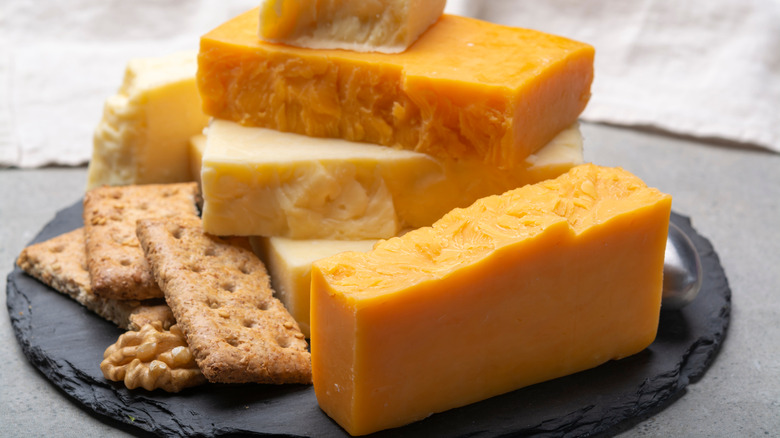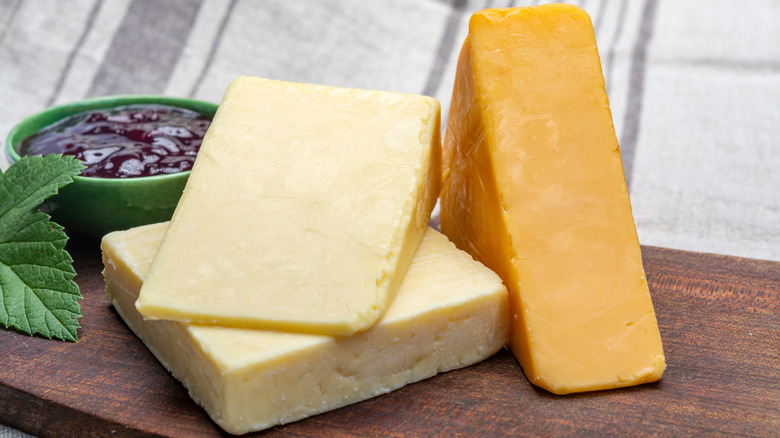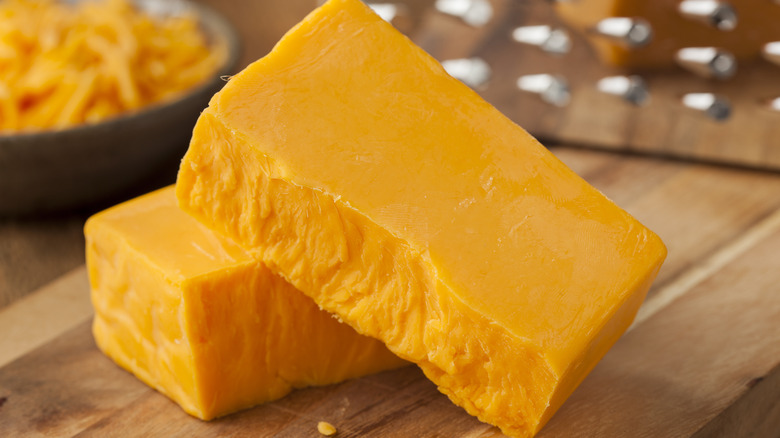How The Color Of Cheddar May Be Able To Tell You Where It Was Made
Cheddar cheese is an American staple, and, for many, it's one of the first cheeses they're introduced to as children. Cheddars can range from mild to sharp; they've got great, tasty flavor, and they're good on sandwiches, burgers, crackers, nachos, and even casseroles. You name it, and cheddar can probably be a part of it! Even this simple mac and cheese recipe calls for sharp cheddar cheese to give it a bit of oomph.
It's known colloquially that cheese comes from milk, so where does cheddar get its orange color from? It turns out that it's partly to do with the diet of the cows and partly to do with ingredients that cheesemakers use. According to Bon Appétit, the grass that cows eat is naturally rich in beta-carotene, which makes the milk slightly yellow-tinted. Back in the day, this was a sign of quality cheese because it meant the cows were well fed. But then, the cheesemakers of yore who wanted to compete decided to up their game, and they began adding coloring and dyes from marigold, saffron, or carrot juice so their cheese would appear higher quality. Nowadays, the color of cheddar cheese isn't indicative of quality but more representative of regionality.
The strange correlation between color and flavor
If you've been shopping for cheese at any time in the recent past, you may have encountered a variety of colors of cheese at your local cheese counter. You've probably noticed that there are different colors of cheddar cheese. Some cheddar is white; some cheddar is yellow; some cheddar is bordering on bright orange. What's fascinating is that different colors of cheddar taste different, but it has nothing to do with the color; it's more to do with the aging of the cheese, notes Cabot.
Cheddar cheese that is made and sold on the East Coast is usually a white cheddar that has a sharper flavor, notes America's Test Kitchen. This flavor has to do with the way the cheese is made, how long it's aged, and the regional preference. The color, or lack thereof, has nothing to do with a white cheddar's sharp, bitey flavor.
Cheddar cheese that comes from the Midwest and the South tends to be a bit milder — it's sharp but sweeter than the East Coast whites and is oftentimes a yellow color. Incidentally, cheddar cheese made in the West and Southwest may be a darker yellow bordering on orange, but it has the sweetest and mildest flavor, also per America's Test Kitchen.
Where does the color come from?
So, it's been established that different cheddars have different flavor profiles and different colors, but if the color doesn't affect the flavor, then where does it come from, and what's the point?
America's Test Kitchen notes that the yellow or orange color in modern cheddar cheese most often comes from a liquid form of annatto which is made from the seeds of the achiote tree. This liquid is tasteless in this use and is only there to give yellow and orange cheddars their signature color.
Cows do still eat beta-carotene-rich grass during the spring and summer and produce more yellow-tinged milk at that time, but when they eat hay in the winter, their milk is whiter, per Bon Appetit. Using annatto means that cheesemakers can keep the color of their product uniform no matter what the season. Next time you approach the cheese counter, you'll remember that the color of cheddar is simply there to signal where it's from and what its flavor profile will be.


